| Pearl History | Pearl Types | Pearl Quality | Pearl Jewelry | Pearl Care |
Pearl History
Pearl Hunting:
For thousands of years, most seawater pearls were retrieved by divers working in the Indian Ocean, in areas like the Persian Gulf, the Red Sea, and in the Gulf of Mannar. Starting in the Han Dynasty (206 BC–220 AD), the Chinese hunted extensively for seawater pearls in the South China Sea. In the 14th-century Arabian Sea, the traveller Ibn Battuta provided the earliest known description of pearl diving by means of attaching a cord to the diver's waist.
When Spanish conquistadors arrived in the Western Hemisphere, they discovered that around the islands of Cubagua and Margarita, some 200 km north of the Venezuelan coast, was an extensive pearl bed (a bed of pearl oysters). One discovered and named pearl, La Peregrina pearl, was offered to the Spanish queen. According to Garcilasso de la Vega, who says that he saw La Peregrina at Seville in 1507, (Garcilasso, "Historie des Incas, Rois du Perou," Amsterdam, 1704, Vol. II, P. 352.) this was found at Panama in 1560 by a slave worker who was rewarded with his liberty, and his owner with the office of alcalde of Panama.
Margarita pearls are extremely difficult to find today and are known for their unique yellowish color. The most famous Margarita necklace that any one can see today is the one that then Venezuelan President Romulo Betancourt gave to Jacqueline Kennedy when she and her husband, President John F. Kennedy paid an official visit to Venezuela.
Before the beginning of the 20th century, pearl hunting was the most common way of harvesting pearls. Divers manually pulled oysters from ocean floors and river bottoms and checked them individually for pearls. Not all mussels and oysters produce pearls. In a haul of three tons, only three or four oysters will produce perfect pearls.
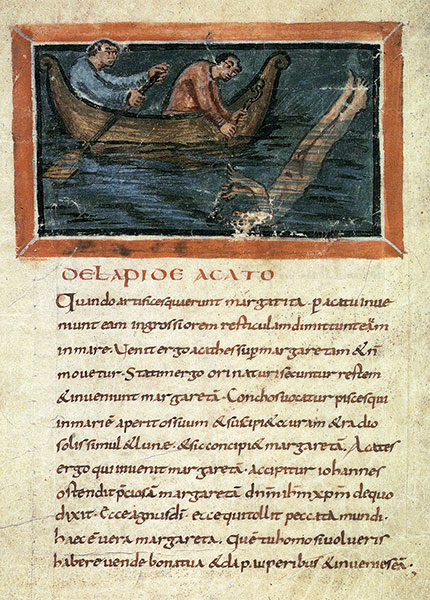
Catching of pearls, Bern Physiologus (IX century)
Pearl Farming:
Today, the cultured pearls on the market can be divided into two categories. The first category covers the beaded cultured pearls, including Akoya, South Sea and Tahiti. These pearls are gonad grown, and usually one pearl is grown at a time. This limits the number of pearls at a harvest period. The pearls are usually harvested after one year for akoya, 2–4 years for Tahitian and South Sea, and 2–7 years for freshwater. This perliculture process was first developed by the British biologist William Saville-Kent who passed the information along to Tatsuhei Mise and Tokichi Nishikawa from Japan. The second category includes the non-beaded freshwater cultured pearls, like the Biwa or Chinese pearls. As they grow in the mantle, where on each wing up to 25 grafts can be implanted, these pearls are much more frequent and saturate the market completely. An impressive improvement in quality has taken place in the last ten years when the former rice grain-shaped pebbles are compared with the near round pearls of today. In the last two years large near perfect round bead nucleated pearls up to 15mm in diameter have been produced with metallic luster.
The nucleus bead in a beaded cultured pearl is generally a polished sphere made from freshwater mussel shell. Along with a small piece of mantle tissue from another mollusk (donor shell) to serve as a catalyst for the pearl sac, it is surgically implanted into the gonad (reproductive organ) of a saltwater mollusk. In freshwater perliculture, only the piece of tissue is used in most cases, and is inserted into the fleshy mantle of the host mussel. South Sea and Tahitian pearl oysters, also known as Pinctada maxima and Pinctada margaritifera, which survive the subsequent surgery to remove the finished pearl, are often implanted with a new, larger beads as part of the same procedure and then returned to the water for another 2–3 years of growth.
Despite the common misperception, Mikimoto did not discover the process of pearl culture. The accepted process of pearl culture was developed by the British Biologist William Saville-Kent in Australia and brought to Japan by Tokichi Nishikawa and Tatsuhei Mise. Nishikawa was granted the patent in 1916, and married the daughter of Mikimoto. Mikimoto was able to use Nishikawa's technology. After the patent was granted in 1916, the technology was immediately commercially applied to akoya pearl oysters in Japan in 1916. Mise's brother was the first to produce a commercial crop of pearls in the akoya oyster. Mitsubishi's Baron Iwasaki immediately applied the technology to the south sea pearl oyster in 1917 in the Philippines, and later in Buton, and Palau. Mitsubishi was the first to produce a cultured south sea pearl – although it was not until 1928 that the first small commercial crop of pearls was successfully produced.
The original Japanese cultured pearls, known as akoya pearls, are produced by a species of small pearl oyster, Pinctada fucata martensii, which is no bigger than 6 to 8 cm in size, hence akoya pearls larger than 10 mm in diameter are extremely rare and highly priced. Today, a hybrid mollusk is used in both Japan and China in the production of akoya pearls.
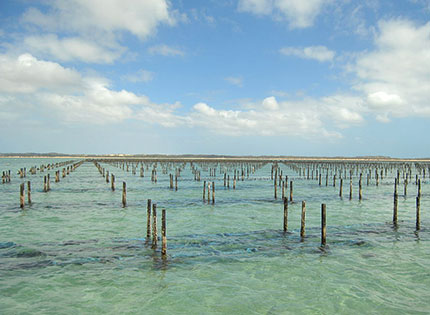
Oyster Farm, South Australia
Pearl production:
In 2010, China overtook Japan in akoya pearl production. Japan has all but ceased its production of akoya pearls smaller than 8 mm. Japan maintains its status as a pearl processing center, however, and imports the majority of Chinese akoya pearl production. These pearls are then processed (often simply matched and sorted), relabeled as product of Japan, and exported.
In the past two decades, cultured pearls have been produced using larger oysters in the south Pacific and Indian Ocean. The largest pearl oyster is the Pinctada maxima, which is roughly the size of a dinner plate. South Sea pearls are characterized by their large size and warm luster. Sizes up to 14 mm in diameter are not uncommon. South Sea pearls are primarily produced in Australia, Indonesia, and the Philippines.
Mitsubishi commenced pearl culture with the south sea pearl oyster in 1916, as soon as the technology patent was commercialized. By 1931 this project was showing signs of success, but was upset by the death of Tatsuhei Mise. Although the project was recommenced after Tatsuhei's death, the project was discontinued at the beginning of WWII before significant productions of pearls were achieved.
After WWII, new south sea pearl projects were commenced in the early 1950s in Burma and Kuri Bay and Port Essington in Australia. Japanese companies were involved in all projects using technicians from the original Mitsubishi south sea pre-war projects.

Pearl diver in Japan
Pearl Types
Tahitian South Sea Pearls:
This darker variety of South Sea pearl is cultured on the beautiful islands of Tahiti in French Polynesia. These pearls are produced by the “Pinctada margaritifera’” or “Black Lip Oyster”. Tahitian pearls prices are determined by their luster, color, shape, size, nacre thickness and beauty. Their color ranges from light to very dark gray, but they are also produced in natural fancy colors like green, pink, lavender, blue and brown.
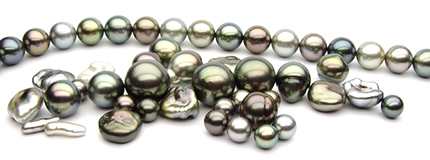
Akoya Pearls:
For centuries, the beauty of Akoya pearls has enchanted the world. This is the most traditional of pearls. Originally produced only in Japan, they have recently begun producing these pearls in Vietnam & China. Akoya pearls come from “Pinctada Martensii” or “Akoya” oysters, which are usually cultured. These pearls have natural colors that range from light pink to white to yellowish. Akoya pearls are known for their high luster and rich color.
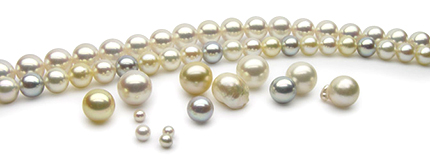
White South Sea Pearls:
White South Sea pearls are valued for their brilliant luster and large size. Cultured White South Sea pearls are produced by one of the largest pearl-bearing oysters, the Pinctada Maxima oyster, along the coasts of Australia, Indonesia, and the Philippines. The oyster which produces White South Sea pearls, commonly known as the Silver-Lipped Oyster, can grow to the size of a dinner plate but it is highly sensitive to the culturing process. This is one of several factors which contribute to the cost and rarity of South Sea Pearls. Another factor is the time it takes to culture South Sea Pearls. It typically takes 1-4 years to culture a South Sea pearl, while, in comparison, Freshwater pearls can be produced in 1–12 months. It can take many years to collect pearls from several harvests, in order to create just one of the magnificent strands you can find at Baggins Pearls.

Golden South Sea Pearls:
Golden South Sea pearls are valued for their brilliant luster, large size and rarity. Cultured Golden South Sea pearls are produced by one of the largest pearl-bearing oysters, the Pinctada Maxima oyster, along the coasts of Australia, Indonesia, and the Philippines. The oyster which produces White South Sea pearls, commonly known as the Gold-Lipped Oyster, can grow to the size of a dinner plate but it is highly sensitive to the culturing process. This is one of several factors which contribute to the cost and rarity of South Sea Pearls. Another factor is the time it takes to culture South Sea Pearls. It typically takes 1-4 years to culture a South Sea pearl, while, in comparison, Freshwater pearls can be produced in 1–12 months. It can take many years to collect pearls from several harvests, in order to create just one of the magnificent strands you can find at Baggins Pearls.
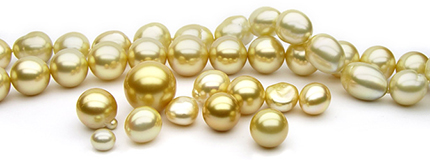
Freshwater Pearls:
Freshwater pearls are primarily cultured using the “Hyriopsis cumingii”, or “Triangle shell” pearl mussel. Freshwater pearls are arguably the most diverse type of pearls produced today. They grow in a huge variety of shapes, a broad range of sizes, and have a natural pastel color palate that ranges from dark purple, to light pink and white. The majority of Freshwater pearls are produced in China, with limited production in Japan.
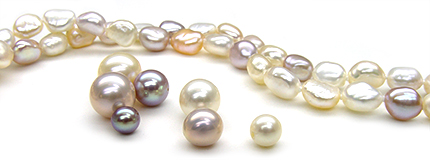
Pearl Quality
Luster:
Luster is widely considered the most important factor in judging a pearls quality. It is the term used to describe the reflectivity of the pearls surface. The higher the pearls luster is, the more it shines, reflecting light and objects more clearly. For a pearl to have a deep mirror-like reflection, it must have a very smooth surface created by many even layers of nacre. Saltwater pearls generally have higher luster than freshwater pearls. Pearls with low luster appear dull or chalky white, instead of brilliant and shiny.
Coating:
The second most important indication of a pearl’s value is the thickness of coating. A pearl is made up of layers and layers of a substance called nacre – calcium carbonate and protein. The thicker the nacre is, the more durable and valuable the pearl. The average thickness of a pearl’s nacre ranges from 1mm to 3mm. Coating cannot be easily judged by an unpracticed eye, but can be determined by how long a pearl has been underwater.
Size:
Generally, as the size of the pearl goes up, the value goes up as well (all other factors being equal.) The standard way pearl sizes are measured is in millimeters (mm). Pearl sizes can range from 1mm (or even less for some seed pearls) up to as large as 20mm for large South Sea Pearls. Large sized pearls are rare, and size has a significant effect on price. A difference of one millimeter can raise the price by a 100 to 200 per cent in the pearl industry. Below is a list of the most common size ranges for the different types of cultured pearls.
Tahitian Pearls: 8mm to 17mm
White and Golden South Sea Pearl: 9mm to 18mm
Akoya Pearl: 2mm to 10mm
Freshwater Pearl: 2mm to 15mm

Shape:
Round - Perfectly round pearls are the most sought after and the rarest of cultured pearls. Because of their rarity and "classic pearl" appeal, they are typically the most highly valued of the pearl shapes. Generally all pearls are nucleated with a round bead in the hopes of culturing a round pearl, but only 5-10% of a pearl farm's harvest will actually result in a pearl that can be qualified as round.
Near-Round - To the untrained eye, near-round pearls have the appearance of being perfectly round pearls, even more so when worn on in a necklace. If the pearls are not perfectly round but very close to round they are considered “near-round” or sometimes called “off-round”. The majority of freshwater pearls on the market will fall into this category.
Button – Button pearls are symmetrical in shape and have a round appearance from the front, with the opposite side being flat. While noticeable when strung as a strand, their button shape can appear as round when set as studs or cufflinks, and are considerably less expensive than round pearls.
Oval – Oval pearls are symmetrical but not perfectly spherical. Oval pearls have the appearance of an elongated round pearl and are considerably less expensive than round pearls. Oval pearls have their widest diameter found at the center of the pearl.
Drop – Drop pearls are symmetrical in shape and have a tear-drop appearance. They are similar to ovals but have one end noticeably thinner than the other, sometimes coming to a distinct point. A pearl that has a perfect "pear-shape" can be very valuable, especially in larger sizes, and may even fetch higher prices than rounds.
Baroque – Baroque pearls are non-symmetrical and have no specific shape designations except for the fact that their shape is irregular. Their shapes can vary from off-round to pebble-shaped to irregular drop shapes. The demand for baroque pearls has steadily increased as more and more consumers and designers gain appreciation for the wide range of unique shapes found in baroque pearls.
Circle - Circle pearls can have a variety of different shapes including baroque, drop, button and near-round. The defining characteristic that designates a pearl as circle is the presence of visible concentric “circles” or “rings” around the diameter of the pearl. Circle pearls are most often found in South Sea and Tahitian Pearls, and are gaining popularity due to their unique appearance and affordability.

Surface:
Pearls are the only organically created gem. Because they are produced by a living creature, tiny surface imperfections are almost always present. The fewer and smaller these imperfections, to more valuable the pearl will be. The size of the pearl should also be taken into account when examining surface blemishes. A larger pearls value will be less affected by small imperfections. Blemish location can also be a factor because if the imperfections are concentrated in one area they won’t be as noticeable as blemishes that are spread out over the pearls surface. Blemishes are also less noticeable if the pearl has high luster.
Color:
Pearls come in a wide variety of natural colors. Basic colors include cream, white, gray, green and pink. A pearls color does not affect its value or quality grade as much as other factors. The most important aspects of a pearls color, in relation to judging its quality, are the saturation and even distribution of its color. While color demand is primarily based on personal preference, rare and intense fancy colors are often sold at a premium.

Grading:
There is no definate industry-recognized standards exist. This means every grading system used by each pearl producer is quite subjective. Baggins Inc grades Pearls based of the above quality attributes designated by industry best practices, not to overwhelmed by the marketting standpoints.
| Grade | AAA | AA | A |
| Luster | Excellent with very high rate and shape reflection | High with good rate and sharp reflection | Medium with low rate and fair reflection |
| Coating | Very Thick | Thick | Thin |
| Shape | Perfect | Near Perfect | Fair |
| Surface | >95% Clean with very few to non blemishes | 80-95% Clean with few blemishes | 70-80% Clean with some blemishes |
| Matching | Very Good | Good | Fair |
Pearl Jewelry
The value of the pearls in jewelry is determined by a combination of the luster, color, size, lack of surface flaw and symmetry that are appropriate for the type of pearl under consideration. Among those attributes, luster is the most important differentiator of pearl quality according to jewelers.
All factors being equal, however, the larger the pearl the more valuable it is. Large, perfectly round pearls are rare and highly valued. Teardrop-shaped pearls are often used in pendants.
Pearls come in eight basic shapes: round, semi-round, button, drop, pear, oval, baroque, and circled. Perfectly round pearls are the rarest and most valuable shape. Semi-rounds are also used in necklaces or in pieces where the shape of the pearl can be disguised to look like it is a perfectly round pearl. Button pearls are like a slightly flattened round pearl and can also make a necklace, but are more often used in single pendants or earrings where the back half of the pearl is covered, making it look like a larger, rounder pearl.
Drop and pear shaped pearls are sometimes referred to as teardrop pearls and are most often seen in earrings, pendants, or as a center pearl in a necklace. Baroque pearls have a different appeal; they are often highly irregular with unique and interesting shapes. They are also commonly seen in necklaces. Circled pearls are characterized by concentric ridges, or rings, around the body of the pearl.
In general, cultured pearls are less valuable than natural pearls, whereas imitation pearls almost have no value. One way that jewelers can determine whether a pearl is cultured or natural is to have a gem lab perform an x-ray of the pearl. If the x-ray reveals a nucleus, the pearl is likely a bead-nucleated saltwater pearl. If no nucleus is present, but irregular and small dark inner spots indicating a cavity are visible, combined with concentric rings of organic substance, the pearl is likely a cultured freshwater. Cultured freshwater pearls can often be confused for natural pearls which present as homogeneous pictures which continuously darken toward the surface of the pearl. Natural pearls will often show larger cavities where organic matter has dried out and decomposed.
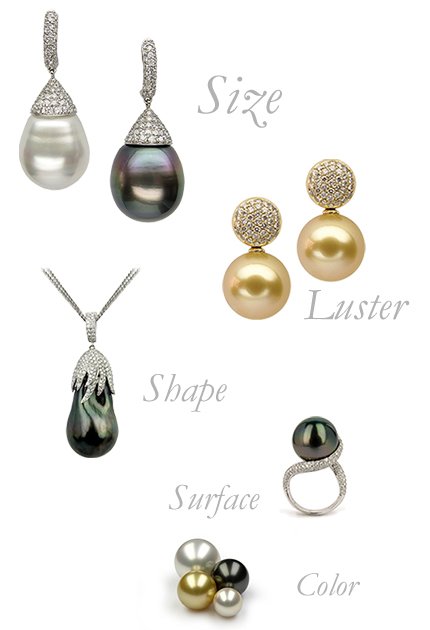
Lengths of Pearl necklaces: There is a special vocabulary used to describe the length of pearl necklaces. While most other necklaces are simply referred to by their physical measurement, pearl necklaces are named by how low they hang when worn around the neck. A collar, measuring 10 to 13 inches or 25 to 33 cm in length, sits directly against the throat and does not hang down the neck at all; collars are often made up of multiple strands of pearls. Pearl chokers, measuring 14 to 16 inches or 35 to 41 cm in length, nestle just at the base of the neck. A strand called a princess length, measuring 17 to 19 inches or 43 to 48 cm in length, comes down to or just below the collarbone. A matinee length, measuring 20 to 24 inches or 50 to 60 cm in length, falls just above the breasts. An opera length, measuring 28 to 35 inches or 70 to 90 cm in length, will be long enough to reach the breastbone or sternum of the wearer; and longer still, a pearl rope, measuring more than 45 inches or 115 cm in length, is any length that falls down farther than an opera.
Necklaces can also be classified as uniform, or graduated. In a uniform strand of pearls, all pearls are classified as the same size, but actually fall in a range. A uniform strand of akoya pearls, for example, will measure within 0.5 mm. So a strand will never be 7 mm, but will be 6.5–7 mm. Freshwater pearls, Tahitian pearls, and South Sea pearls all measure to a full millimeter when considered uniform.
A graduated strand of pearls most often has at least 3 mm of differentiation from the ends to the center of the necklace. Popularized in the United States during the 1950s by the GIs bringing strands of cultured akoya pearls home from Japan, a 3.5 momme, 3 mm to 7 mm graduated strand was much more affordable than a uniform strand because most of the pearls were small.
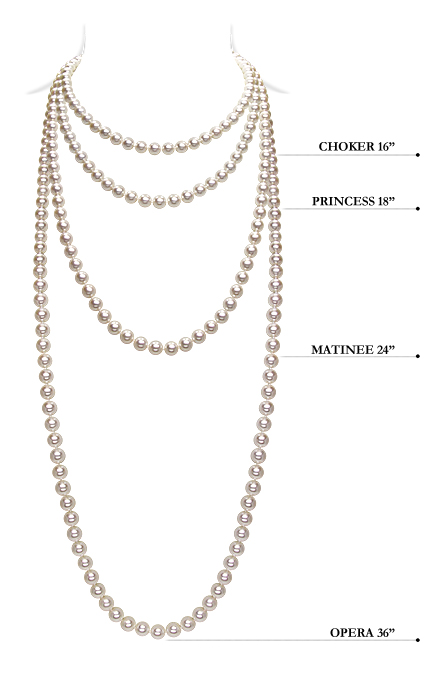
Pearl Care
Indeed the radiance and beauty of a genuine quality pearl can be preserved lifelong with a bit of care. Being formed naturally, with layers of predominantly calcium based minerals; pearls are susceptible to both acidic and alkaline chemicals. Therefore, pearls should never be washed with strong soap or detergent solutions. Pearls can be worn frequently, and with the following precautions, preserve their beauty forever.
Wearing Pearl Jewelry: Pearls should be put on last while dressing up, and taken off first when dressing down. This is to prevent the harmful effects perfumes and cosmetics have on pearls. It’s a good idea to put your pearls on at least 30-minutes after you’ve put on perfumes or cosmetics.
Keeping Pearl Jewelry: While safe keeping, prevent pearls coming in direct contact with other hard precious stones such as diamonds, etc. It is a good idea to store pearls wrapped in a soft cloth.
Cleaning Pearl Jewelry: Tenderly wipe off pearls with a soft cloth every time after wearing. Occasional cleaning with warm water and a touch of alcohol or a very dilute soap solution is recommended. After cleaning the pearls individually with a soft cloth moistened with this solution, wipe the pearls off with a soft cloth dampened with clean water. Finally, dry the pearls with a soft cloth before storing.
Re-stringing Pearl Necklaces: If you wear your pearl necklace on a regular basis, you should have it professionally re-strung about once a year to ensure all the pearls are secure. The necklace should be strung with knots between each pearl to safeguard against all of the pearls falling off should the necklace thread break. The knots also protect the pearls from rubbing against each other and wearing down the nacre coating. It is a good idea to occasionally inspect your necklace for any weak spots in the thread or fraying.
